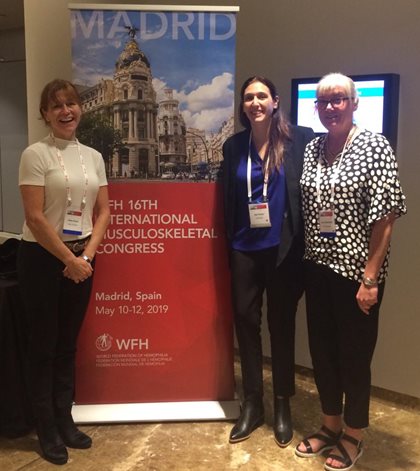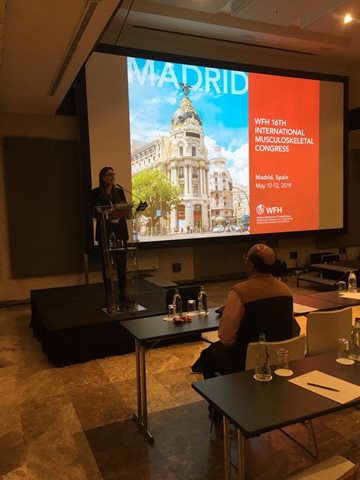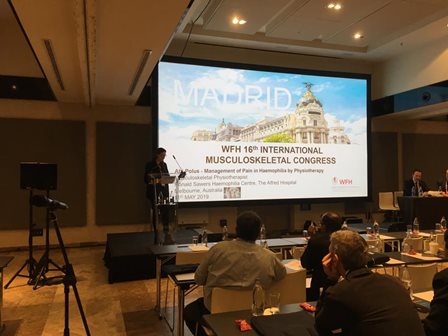ABI POLUS, LEE TOWNSEND AND HELEN DIXON
Abi Polus is Senior Clinical Physiotherapist – Haemophilia, Alfred Health, Melbourne.
Lee Townsend is Haemophilia Physiotherapist, Christchurch Hospital, New Zealand.
Helen Dixon is Expert Physiotherapist Haemophilia, Wellington Hospital, New Zealand.
Three physiotherapists from Australia and New Zealand, Abi Polus, Lee Townsend and Helen Dixon, were fortunate to attend the World Federation of Haemophilia (WFH) Musculoskeletal Congress, held in Madrid, Spain in May 2019.

L-R: Helen Dixon, Abi Polus and Lee Townsend at the MSK Congress
Photo: Lee Townsend
This was the largest ever Musculoskeletal Congress with 425 delegates from 76 countries coming together to discuss current and emerging evidence and best practice in the management of the musculoskeletal issues that arise due to haemophilia. It was agreed by the delegation that although haemophilia is a haematological condition, the musculoskeletal aspects currently appear to be the most challenging to manage overall.
There was a variety of sessions, from management of pain, the complexity of obesity, treatment strategies for joint pathology, nurturing the athlete, the use of ultrasound, outcome measures, and current research. Global areas of need were highlighted, which was especially humbling and made us very grateful for what we have available in Australia and New Zealand. Speakers were from a range of disciplines, including physiotherapists, orthopaedic surgeons, rehabilitation specialists, haematologists, researchers and patients, and were knowledgeable and engaging.

The Congress began with the ‘Madrid point of view’ on musculoskeletal problems of haemophilia. Carlos Rodriguez-Merchan, an orthopaedic surgeon, and Hortensia de la Corte, a specialist in physical medicine and rehabilitation, spoke on their Haemophilia Treatment Centre’s experience.
They described radiosynovectomy as a simple effective and safe procedure for the control of chronic haemophiliac synovitis. Their indication for this procedure was 2 or more episodes of haemarthrosis in 6 months and that patients can have up to 3 repeated injections every 6 months. They suggested that confirmation of synovitis must be by ultrasound and clinical examination. This is a common procedure in Madrid and is available in both Australia and New Zealand in specific Centres, when clearly indicated.
Other orthopaedic procedures carried out on patients with haemophilia described by the Madrid team were knee, ankle and elbow operations to improve function following joint arthropathy. They reported their statistics of the many total knee replacements that had been done with good outcomes. Ankle arthrodesis (fusion) was their preferred operative option over ankle replacement as complications were about double with replacement compared to fusion. They noted that the literature suggests complications with total elbow replacements can be as high as 60% so they believe that the risks are too great to recommend them to the cohort in Madrid. It is well established in general literature that total elbow replacements can significantly decrease pain but function may be usually affected. In Australia and New Zealand it is suggested that elbow surgery should be decided on an individual basis, with collaboration with between the patient, surgeon, and haemophilia team.
The Madrid team have now started doing ultrasound guided evacuation of muscle haematomas to decrease the risk of pseudotumours. In Australia and New Zealand this is an extremely rare complication, often although not exclusively, linked with poor management of bleeds. In countries where factor replacement is unavailable or insufficient these are more common. The role of joint aspiration in acute haemarthrosis remains controversial. The blood must be in the liquid phase, joints assessed by ultrasound, be under factor cover and be performed under ultrasound guidance. The Madrid HTC carried out a study with patients assigned to either the aspiration group or to the control group. There were 55 patients with acute joint bleeding episodes in the study. Joints treated with joint aspiration exhibited a significantly faster resolution of bleeding (15 less than control), 6 less days of factor treatment, 4 days less of pain, 10 less days to restore range of movement and 4 days less to return to work or school. They reported that there were no short or long-term complications. The Madrid group concluded that in their cohort, under their conditions, this is a safe and effective procedure that allowed faster recovery in their patients with haemophilia following an acute bleed. To achieve this, it must be done in a Haemophilia Treatment Centre with multidisciplinary input.

A session on obesity was presented by Jens-Christian Holm, Consultant Paediatrician Denmark, Dari Di Minno, Professor of Medical Science, Italy, Nichan Zourikain, Physiotherapist, Canada, Mauricio Silva, Orthopaedic Surgeon, USA and Mathieu Jackson, Canadian Haemophilia Society.
The World Health Organisation recognised obesity as a disease as long ago as 1948. As we all know, since then – and particularly over the last decade – this disease has grown at epidemic proportions, almost tripling since 1975.
Recognition and treatment of obesity in the haemophilia community is still not well documented or researched. The presenters pointed out a few studies that show the haemophilia population mirrors obesity trends in the general population.
Obesity does appear to have an impact on the health of people with haemophilia and particularly their joint health. When they are obese, there appears to be up to 30% more joint bleeds and an increase in the HEAD-US (Haemophilia Early Arthropathy Detection with Ultrasound) score as well as increased risk of musculoskeletal injury. There is also significantly more risk associated with surgery.
As factor replacement dosing is calculated on body weight, there was suggestion that this should be calculated on ideal body weight rather than actual weight in obese patients. This is more accurate for calculating circulating factor levels as adipose tissue does not circulate clotting factor. This should be confirmed with PK studies.
Overall, the presenters concluded that overweight and obesity represent major issues in people with haemophilia. Targeted prevention and treatment solutions need to be implemented for this group.
Haemophilic arthropathy
Another highlight was the session on haemophilic arthropathy. This was presented by Christian Carulli, Orthopaedic Surgeon, Italy, Maria Eulalia Landro, Biologist, Argentina, and Lize Van Vulpen, Haematologist, Netherlands.
Joint regeneration following blood induced damage and repair of articular cartilage is a great challenge as cartilage cells do not regenerate. Mild to moderate joint disease is difficult to treat as the treating team usually wait until it is severe and orthopaedic intervention is needed. Novel therapies such as bone marrow stimulation, stem cell injection, growth factor treatment, platelet-rich plasma injection and joint distraction all need further clinical trials to demonstrate safety and efficacy.
Intra-articular injection of hyaluronic acid has been shown to be helpful in a small number of patients in a few studies of mild to moderate arthropathy of the knee. However, it doesn’t appear as effective as steroid injection for reducing pain in the short to medium term.
Intra-articular injection of platelet-rich plasma is thought to be anti-inflammatory, regenerational, anti-microbial and an immunomodulatory. All of these are very useful properties for the treatment of synovitis. A 3-year follow-up study based in Argentina with 84 patients and 144 joints showed a significant reduction in joint pain, number of bleeds and Haemophilia Joint Health Score and an increase in range of movement and joint function.
Clearly more research is needed in this very interesting and exciting area of joint arthropathy treatment.

Abi speaking at the MSK Congress
Photo: Abi Polus
A patient-focused session on nurturing the athlete brought together three high-achieving patients from three different countries, who presented their experiences and achievements in a panel discussion. The countries represented, it should be noted, allow them to have access to regular and tailored factor replacement or by-passing agents. The patients were Andrew Selvaggi, personal trainer, Australia; Clive Smith, Ironman triathlete, United Kingdom; and Pau Salva Martinez, competitive cyclist, Spain. Also on the panel was Dr Sebastien Lobet, haemophilia physiotherapist and researcher, Belgium.
Particularly interesting were the changes in medication, management and attitudes they highlighted that had come about within their lifespans thus far (of around 30-40 years). They discussed the attitudes of their respective Haemophilia Treatment Centres, both the positives and negatives, and described the importance of clinicians listening to and supporting their personal choices and managing their specific needs as paramount. Interestingly, they reported that they would have done these things anyway, regardless of their clinicians’ support or the lack of. Thankfully they all reported support from their current physiotherapists (phew), but it did reiterate how we can guide, advise and educate but, most importantly, collaborate with our patients.
It also demonstrated that there are few limits to what people with haemophilia can achieve: overcoming physical impairments to embrace and promote physical career pathways; compete in an ironman or four (that’s a 3.86 km swim, 180.25 km bicycle ride and then a 42.20 km marathon run, raced in that order and without a break) for fun; a race for your country in the toughest cycle ride in the world (and win!); an active dream-career, or choose whatever you put your mind to. A question at the end of the session was posed to each presenter: ‘would you have achieved what you have if you did not have your bleeding disorder?’ and each participant stated a resounding no.
MSK and the future of haemophilia
Musculoskeletal management and the future of haemophilia was an extremely interesting way to reflect forward to what changes may come. Gene therapy and new agents were discussed by Dr Maria E Mancuso, Italy, along with the effects they may have on joint protection and management of haemophilia. In an excellent presentation, Canadian physiotherapist Karen Strike discussed the use of an app which can monitor PK (pharmacokinetics) and looked towards the use of artificial intelligence in outcome measures and management strategies in the future.
The conference was extremely informative, Madrid put on spectacular weather for us, the food and drink was wonderful and we all were grateful for the opportunity to be able to discuss what we do with colleagues and musculoskeletal specialists from around the world to enhance our own practice and bring it to our own centres and patients.

Abi speaking at the Congress
Photo: Abi Polus
Abi Polus was funded by Haemophilia Foundation Australia to attend the WFH Musculoskeletal Congress.
This article was published simultaneously in Bloodline, the magazine of the Haemophilia Foundation of New Zealand.
Haemophilia Foundation Australia acknowledges the Traditional Owners and Custodians of Country throughout Australia, the land, waters and community where we walk, live, meet and work. We pay our respects to Elders past and present and extend that respect to all Aboriginal and Torres Strait Islander peoples.
Sign up for the latest news, events and our free National Haemophilia magazine